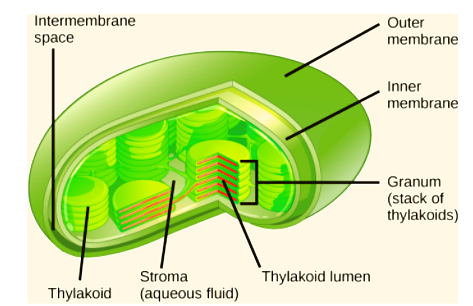
The packet of thylakoid in a chloroplast is called
A. Fret channels
B. Granum
C. Stroma Thylakoid
D. Photosynthesis Thylakoid
Answer
571.2k+ views
Hint: A stack of thylakoid discs is organized to form grana. A thylakoid refers to the membrane-bound internal compartment within the chloroplasts of a plant cell and cyanobacteria.
Complete answer:
It is a site for light-dependent reactions of photosynthesis.
1. There are about 10 to 100 thylakoid discs within a granum and about 40- 60 grams in a plant cell.
The thylakoid is the individual disk, the stroma is the substance surrounding the thylakoids.
2. The chloroplast is an organelle, like the mitochondria, where energy is produced for plants. Chlorophyll is the color absorbing pigments that are inside the thylakoid, and aid in capturing electrons from light.

3. Carotenoids are orange and are also pigments found in chloroplasts and are more abundant in flowers and fruits. Stroma, in botany, refers to the colorless fluid surrounding the grana within the chloroplast.
Within the stroma are grana (stacks of thylakoid), and the sub-organelles or daughter cells, where photosynthesis is commenced before the chemical changes are completed in the stroma.
4. In cyanobacteria, algae, and plants, the light reactions of photosynthesis are performed by large protein complexes embedded in the thylakoid membranes.
5. In higher plant chloroplasts, thylakoid membranes have a distinct architecture, forming an intricate network of stacks of flattened or appressed lamellae called grana that are connected by unstacked stroma thylakoids that traverse the chloroplast stroma matrix.
6. While the organization of thylakoid membranes into grana and stroma regions is universally observed in mature land plant chloroplasts. Cyanobacterial thylakoid membranes have not been found to form grana stacks connected by stroma thylakoids.
So, the correct answer is “Option B”.
Note: The tubular membrane connections, however, do seem to be similar in shape and size in the two systems. To date, Cyanothece 51142 is the only cyanobacterium in which any helical architecture has been reported, compared to the universality of grana-stroma architecture in higher plants.
Complete answer:
It is a site for light-dependent reactions of photosynthesis.
1. There are about 10 to 100 thylakoid discs within a granum and about 40- 60 grams in a plant cell.
The thylakoid is the individual disk, the stroma is the substance surrounding the thylakoids.
2. The chloroplast is an organelle, like the mitochondria, where energy is produced for plants. Chlorophyll is the color absorbing pigments that are inside the thylakoid, and aid in capturing electrons from light.

3. Carotenoids are orange and are also pigments found in chloroplasts and are more abundant in flowers and fruits. Stroma, in botany, refers to the colorless fluid surrounding the grana within the chloroplast.
Within the stroma are grana (stacks of thylakoid), and the sub-organelles or daughter cells, where photosynthesis is commenced before the chemical changes are completed in the stroma.
4. In cyanobacteria, algae, and plants, the light reactions of photosynthesis are performed by large protein complexes embedded in the thylakoid membranes.
5. In higher plant chloroplasts, thylakoid membranes have a distinct architecture, forming an intricate network of stacks of flattened or appressed lamellae called grana that are connected by unstacked stroma thylakoids that traverse the chloroplast stroma matrix.
6. While the organization of thylakoid membranes into grana and stroma regions is universally observed in mature land plant chloroplasts. Cyanobacterial thylakoid membranes have not been found to form grana stacks connected by stroma thylakoids.
So, the correct answer is “Option B”.
Note: The tubular membrane connections, however, do seem to be similar in shape and size in the two systems. To date, Cyanothece 51142 is the only cyanobacterium in which any helical architecture has been reported, compared to the universality of grana-stroma architecture in higher plants.
Recently Updated Pages
Master Class 12 Business Studies: Engaging Questions & Answers for Success

Master Class 12 Social Science: Engaging Questions & Answers for Success

Master Class 12 English: Engaging Questions & Answers for Success

Master Class 12 Chemistry: Engaging Questions & Answers for Success

Class 12 Question and Answer - Your Ultimate Solutions Guide

Master Class 12 Economics: Engaging Questions & Answers for Success

Trending doubts
What are the major means of transport Explain each class 12 social science CBSE

Which are the Top 10 Largest Countries of the World?

Draw a labelled sketch of the human eye class 12 physics CBSE

How much time does it take to bleed after eating p class 12 biology CBSE

Explain sex determination in humans with line diag class 12 biology CBSE

Differentiate between homogeneous and heterogeneous class 12 chemistry CBSE




